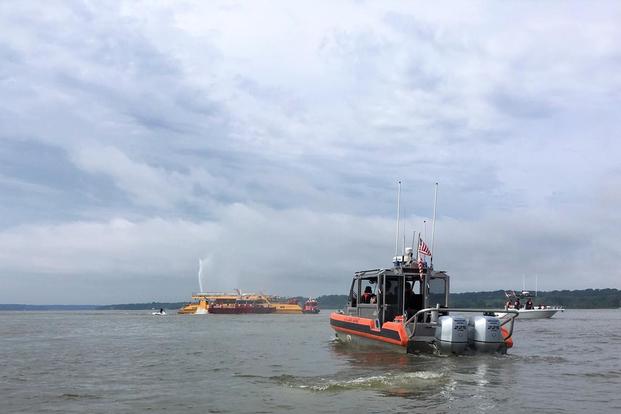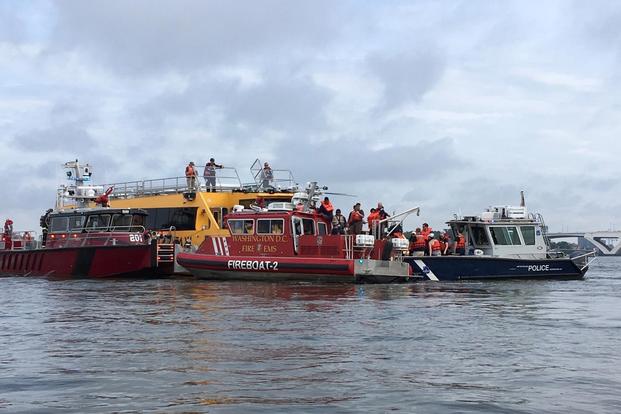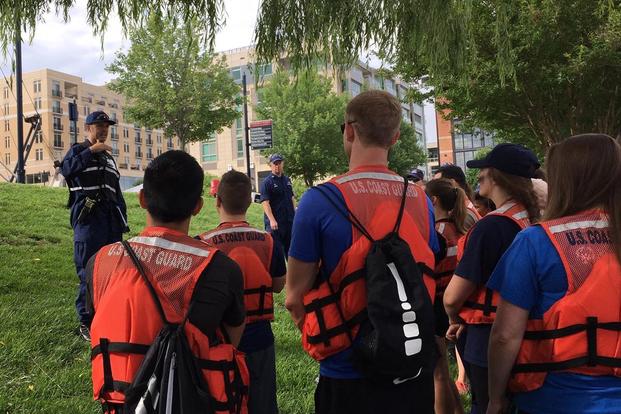NATIONAL HARBOR, Md. -- The boats swarmed in within minutes of the first 911 call, from a large yellow water taxi billowing smoke on the Potomac River.
Across the water came cries of "Help us!, Help us!" from riders crowding on the top deck to escape the dark, oily plume.
"Someone help! He's having a heart attack!" screamed a panicked woman.
The scenario -- a stricken watercraft on fire carrying dozens of men, women, children, and the elderly, some of whom could not swim -- was a scheduled training exercise that took place Tuesday. But for all involved, it was badly needed preparation for an all-too plausible emergency near the nation's capital.
"We are here to test how well our agencies work together and respond to some kind of critical incident like a mass rescue," Coast Guard Public Affairs Specialist 1st Class Andy Kendrick told Military.com.
Nine months in the works, the Mass Rescue Operations Full-Scale Exercise drew participants from the Prince George's County, Maryland, Fire and Police departments; Washington D.C. Fire and Police as well as D.C. Harbor Patrol; Maryland Department of Natural Resources Police; Coast Guard Sector Maryland-National Capital Region; Alexandria, Virginia, Emergency Management Department; U.S. Park Police and others.
The training objectives included establishing an incident command post to control the response, observing and evaluating rescue preparedness, assessing participants' ability to function together and validating communications procedures and protocols.
"The Coast Guard, state and local agencies take these responses very seriously. We practice and work together so we can be prepared in the event of an actual emergency," said Capt. Joseph Loring, Sector Maryland-National Capital Region commander. "We do this routinely but we haven't done anything quite this large in quite some time."
While Loring said the training scenario "is not a likely event," it comes following a number of deadly, high-profile mishaps involving tourist boats in the past year. In May, a cruise ship struck a sightseeing boat on the Danube River in Budapest, killing 28 people.
Last summer, a duck boat full of tourists capsized on Table Rock Lake, Missouri, tossing 31 people into the water during a driving thunderstorm. Seventeen, including nine members of the same family, died.
In Tuesday's scenario, no one ended up in the water; the Coast Guard used life jackets to simulate persons overboard. Each volunteer on the water taxi was assigned a character. Children and the injured were picked up first and transported to shore to waiting emergency vehicles; those who were fit and not in danger stayed on board while awaiting additional responders.
Pradip Ramamurti, a third-year medical student at George Washington University School of Medicine, was among the last four "victims" removed from the boat. While he and fellow students from GWU and Howard University College of Medicine were participating in the exercise as volunteers, they also had a vested interest in the proceedings: all are studying disaster and emergency response medicine, and many volunteer with the D.C. Reserve Medical Corps, which provides volunteer medical personnel for large events in Washington and mass emergencies.
"Basically today we were recruited to act as victims on the boat. But for us this helps, because we actually have to learn what it is like [being a victim]," Ramamurti said
"It's like being on the other side of disaster medicine," added GWU student Andy Elovic.
Within four minutes of the first mock 911 calls, police from Prince George's County were on the scene; the fireboat arrived shortly thereafter, coming from about a mile away. The response drew patrol boats, fire and rescue and even an airboat from Ronald Reagan National Airport.
Prince George's County Northern Emergency Management Systems Duty Officer Capt. Brian Ludden said he was pleased with the response, especially the coordination between the 15 agencies involved.
It was critical, he said, to "have everyone on the same page."
"The big thing is the communications on the radio. We all switched over to a unified command, using a maritime channel. Everyone was able to talk to each other. We don't normally practice that," Ludden said.
After the exercise was over, the agencies met to discuss the exercise and get feedback from all participants, including the "victims." Evaluators, including those from the Coast Guard and area emergency responders, will develop a post-exercise after-action report that will guide future exercises and operations.
"There are definitely overlapping capabilities and jurisdictions. And trying to figure all that out and save lives as effectively as possible is really important," Kendrick said.
-- Patricia Kime can be reached at Patricia.Kime@Military.com. Follow her on Twitter at @patriciakime.
















